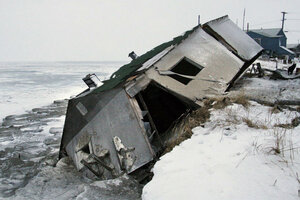Why an Alaskan village voted to leave ancestral home behind
Residents of Shishmaref, Alaska, might finally pack and move, though this is their third vote to relocate as rising sea waters continue to erode the village's shores.

Nathan Weyiouanna's abandoned house at the west end of Shishmaref, Alaska, sits on the beach on Dec. 8, 2006, after sliding off during a fall storm in 2005.
Diana Haecker/File/AP/File
Residents of Shishmaref, Alaska, voted Wednesday to relocate its ancestral island home to safer ground, escaping eroding shores and rising seas brought on by climate change.
Melting sea ice has strengthened the storms that beat along the island's shores, causing chunks to drop off into the ocean, even as the permafrost on which the community is built is rapidly disappearing.
Home to about 650 Inupiat Inuit, an Alaskan native people, the village is located on a narrow island just north of the Bering Strait. The unofficial vote count came in at 89 in favor of moving and 78 for staying, the city clerk told the Associated Press on Wednesday, although absentee and special needs ballots haven't been included in the total.
Warming at twice the rate of the rest of the country, Alaska is at the fore of efforts to mitigate climate change's effects. Shishmaref is among 31 Alaskan villages the US Government Accountability Office says are facing imminent threats from flooding and erosion. But its not clear that the federal government will help pay for these villages to move.
Many of the villages fail to qualify for the Department of Housing and Urban Development's (HUD) Community Development Block Grant program because of their unincorporated governing structures.
It would cost about $180 million to relocate the village, according to an Army Corps of Engineers study, and it's unclear where this money would come from. The US Department of Interior has set aside $8 million for all tribes seeking relocation, and Shishmaref is among at least 12 Alaskan villages that have voted to pick up and move to safer sites.
Residents hope to find a nearby site on the mainland, but they worry about giving up their traditional way of living.
Climate change could displace as many as 200 million people by 2050, according to the United Nations Institute for Environment and Human Security and the International Organization for Migration. Farmers and fishermen whose livelihoods depend on their environments are often the first to feel the effects of climate change.
In the absence of sufficient state and federal funding, city council secretary Donna Burr said she didn't see an immediate opportunity to relocate in a interview with Grist. "It's not going to happen in our lifetimes," she predicts. "We just want to take the right steps forward for our children."
"I was born in 1997, and since then, Shishmaref has lost about 100 feet," Esau Sinnock wrote in an essay for the US Department of Interior. "In the past 15 years, we had to move 13 houses – including my dear grandma Edna's house – from one end of the island to the other because of this loss of land. Within the next two decades, the whole island will erode away completely." The loss of ice has interfered with the villagers' ability to hunt and fish, which is necessary for the survival of the people who depend on subsistence living.
Residents of Shishmaref have previously recognized the need to leave their homes, voting to relocate in May 1973 and again in July 2002, but failed to identify a stable permanent home or drum up the funds and motivation to abandon the community they had built together. But now, there's a precedent.
America's first climate change refugees, surprisingly enough, aren't from Alaska.
HUD set aside its first grant for climate change refugees in February. The residents of Isle de Jean Charles, La., Biloxi-Chitimacha-Choctaw native Americans, were given a $48 million federal grant to pick up their homeland, which is being swallowed up into the Gulf of Mexico after decades of oil extraction practices and a failed levee project worsened storms, exacerbated by the effects of climate change and rising sea levels.

